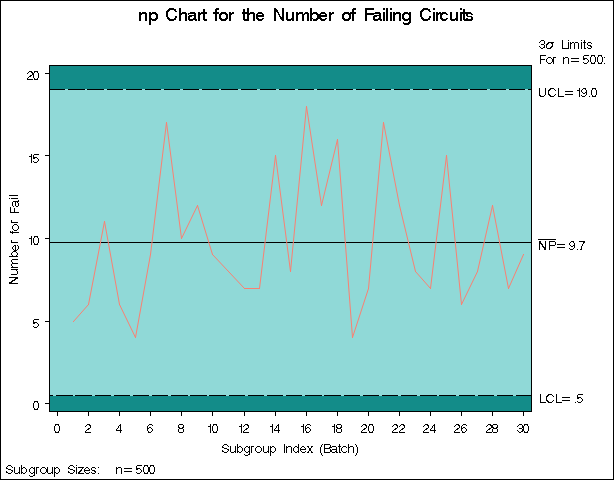NPCHART Statement: SHEWHART Procedure
See SHWNP1 in the SAS/QC Sample LibraryThe previous example illustrates how you can create ![]() charts using raw data (counts of nonconforming items). However, in many applications, the data are provided in summarized
form as proportions or percentages of nonconforming items. This example illustrates how you can use the NPCHART statement
with data of this type.
charts using raw data (counts of nonconforming items). However, in many applications, the data are provided in summarized
form as proportions or percentages of nonconforming items. This example illustrates how you can use the NPCHART statement
with data of this type.
The following data set provides the data from the preceding example in summarized form:
data Cirprop; input Batch pFailed @@; sizes=500; datalines; 1 0.010 2 0.012 3 0.022 4 0.012 5 0.008 6 0.018 7 0.034 8 0.020 9 0.024 10 0.018 11 0.016 12 0.014 13 0.014 14 0.030 15 0.016 16 0.036 17 0.024 18 0.032 19 0.008 20 0.014 21 0.034 22 0.024 23 0.016 24 0.014 25 0.030 26 0.012 27 0.016 28 0.024 29 0.014 30 0.018 ;
A partial listing of Cirprop is shown in Figure 17.52. The subgroups are still indexed by Batch. The variable pFailed contains the proportions of nonconforming items, and the variable Sampsize contains the subgroup sample sizes.
Figure 17.52: The Data Set Cirprop
| Subgroup Proportions of Nonconforming Items |
| Batch | pFailed | sizes |
|---|---|---|
| 1 | 0.010 | 500 |
| 2 | 0.012 | 500 |
| 3 | 0.022 | 500 |
| 4 | 0.012 | 500 |
| 5 | 0.008 | 500 |
The following statements create an ![]() chart identical to the one in Figure 17.51:
chart identical to the one in Figure 17.51:
title 'np Chart for the Number of Failing Circuits';
symbol v=dot;
proc shewhart data=Cirprop;
npchart pFailed*Batch / subgroupn=Sampsize
dataunit =proportion;
label pFailed = 'Number of FAIL';
run;
The DATAUNIT= option specifies that the values of the process (pFailed) are proportions of nonconforming items. By default, the values of the process are assumed to be counts of nonconforming items (see the previous example).
Alternatively, you can read the data set Cirprop by specifying it as a HISTORY= data set in the PROC SHEWHART statement. A HISTORY= data set used with the NPCHART statement
must contain the following variables:
-
subgroup variable
-
subgroup proportion of nonconforming items variable
-
subgroup sample size variable
Furthermore, the names of the subgroup proportion and sample size variables must begin with the process name specified in the NPCHART statement and end with the special suffix characters P and N, respectively.
To specify Cirprop as a HISTORY= data set and Fail as the process, you must rename the variables pFailed and Sampsize to FailP and FailN, respectively. The following statements temporarily rename pFailed and Sampsize for the duration of the procedure step:
options nogstyle;
goptions ftext=swiss;
title 'np Chart for the Number of Failing Circuits';
proc shewhart history=Cirprop(rename=(pFailed =FailP
sizes=FailN ));
npchart Fail*Batch / cframe = vibg
cinfill = vlibg
coutfill = salmon
cconnect = salmon;
run;
options gstyle;
The NOGSTYLE system option causes ODS styles not to affect traditional graphics. Instead, the NPCHART statement options control
the appearance of the graph. The GSTYLE system option restores the use of ODS styles for traditional graphics produced subsequently.
The resulting ![]() chart is shown in Figure 17.53.
chart is shown in Figure 17.53.
In this example, it is more convenient to use Cirprop as a DATA= data set than as a HISTORY= data set. As illustrated in the next example, it is generally more convenient to use
the HISTORY= option for input data sets that have been created previously by the SHEWHART procedure as OUTHISTORY= data sets.
For more information, see HISTORY= Data Set.

